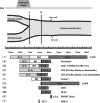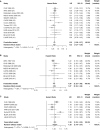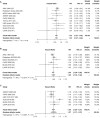Varying Definitions of Carotid Intima-Media Thickness and Future Cardiovascular Disease: A Systematic Review and Meta-Analysis
- PMID: 38014663
- PMCID: PMC10727343
- DOI: 10.1161/JAHA.123.031217
Varying Definitions of Carotid Intima-Media Thickness and Future Cardiovascular Disease: A Systematic Review and Meta-Analysis
Abstract
Background: Carotid intima-media thickness (cIMT) has been widely used as a predictor of future cardiovascular disease (CVD); however, various definitions of cIMT exist. This study provides a systematic review and meta-analysis of the associations between different cIMT definitions and CVD.
Methods and results: A systematic review of the different cIMT definitions used in prospective cohort studies was performed. The relationships between cIMT of different definitions (common carotid artery IMT [CCA-IMT], internal carotid artery IMT [ICA-IMT], combined segments [combined-IMT], mean CCA-IMT, and maximum CCA-IMT) with future stroke, myocardial infarction (MI), and CVD events were analyzed using random effects models. Among 2287 articles, 18 articles (14 studies) with >10 different cIMT definitions were identified and included in our meta-analysis. After adjusting for age and sex, a 1-SD increase in CCA-IMT was associated with future stroke (hazard ratio [HR], 1.32 [95% CI, 1.27-1.38]), MI (HR, 1.27 [95% CI, 1.22-1.33]), and CVD events (HR, 1.28 [95% CI, 1.19-1.37]). A 1-SD increase in ICA-IMT was related to future stroke (HR, 1.25 [95% CI, 1.11-1.42]) and CVD events (HR, 1.25 [95% CI, 1.04-1.50]) but not MI (HR, 1.26 [95% CI, 0.98-1.61]). A 1-SD increase in combined-IMT was associated with future stroke (HR, 1.30 [95% CI, 1.08-1.57]) and CVD events (HR, 1.36 [95% CI, 1.23-1.49]). Maximum CCA-IMT was more strongly related than mean CCA-IMT with risk of MI, and both measures were similarly associated with stroke and CVD events.
Conclusions: Combined-IMT is more strongly associated with CVD events compared with single-segment cIMT definitions. Maximum CCA-IMT shows a stronger association with MI than mean CCA-IMT. Further research is warranted to validate our findings and to standardize the cIMT measurement protocol, as well as to explore underlying mechanisms.
Keywords: atherosclerosis; cardiovascular disease risk; carotid intima‐media thickness; meta‐analysis; segment/definition.
Figures







Similar articles
-
Carotid intima-media thickness progression and risk of vascular events in people with diabetes: results from the PROG-IMT collaboration.Diabetes Care. 2015 Oct;38(10):1921-9. doi: 10.2337/dc14-2732. Epub 2015 Jul 15. Diabetes Care. 2015. PMID: 26180107 Free PMC article. Review.
-
Carotid intima-media thickness progression to predict cardiovascular events in the general population (the PROG-IMT collaborative project): a meta-analysis of individual participant data.Lancet. 2012 Jun 2;379(9831):2053-62. doi: 10.1016/S0140-6736(12)60441-3. Epub 2012 Apr 27. Lancet. 2012. PMID: 22541275 Free PMC article.
-
Carotid intima-media thickness and plaque in cardiovascular risk assessment.JACC Cardiovasc Imaging. 2014 Oct;7(10):1025-38. doi: 10.1016/j.jcmg.2013.11.014. Epub 2014 Jul 16. JACC Cardiovasc Imaging. 2014. PMID: 25051948 Review.
-
Risk factors and their impact on carotid intima-media thickness in young and middle-aged ischemic stroke patients and controls: the Norwegian Stroke in the Young Study.BMC Res Notes. 2014 Mar 26;7:176. doi: 10.1186/1756-0500-7-176. BMC Res Notes. 2014. PMID: 24669965 Free PMC article. Clinical Trial.
-
Impact of Intima-Media Thickness Progression in the Common Carotid Arteries on the Risk of Incident Cardiovascular Disease in the Suita Study.J Am Heart Assoc. 2018 Jun 1;7(11):e007720. doi: 10.1161/JAHA.117.007720. J Am Heart Assoc. 2018. PMID: 29858361 Free PMC article.
Cited by
-
Reply to the comments of Saleh et al. on "Coexistence of high visceral fat area and sarcopenia and atherosclerotic markers in old-old patients with diabetes: Is there an association?".J Diabetes Investig. 2025 Feb;16(2):348-349. doi: 10.1111/jdi.14345. Epub 2024 Nov 6. J Diabetes Investig. 2025. PMID: 39503153 Free PMC article. No abstract available.
-
Influence of Dietary Intake on Carotid Maximum Intima-Media Thickness in Children Conceived Through Assisted Reproductive Techniques.Nutrients. 2025 Mar 28;17(7):1189. doi: 10.3390/nu17071189. Nutrients. 2025. PMID: 40218948 Free PMC article.
-
Segment-Specific Analysis of Carotid Intima-Media Thickness and Its Association with Cardiovascular Risk Factors in a Large Healthy Cohort.J Clin Med. 2025 Mar 12;14(6):1918. doi: 10.3390/jcm14061918. J Clin Med. 2025. PMID: 40142726 Free PMC article.
-
Relationship Between Carotid Artery Remodeling Characteristics and Early Carotid Atherosclerosis: An Ultrasonographic Multicenter Study.J Ultrasound Med. 2025 May;44(5):915-925. doi: 10.1002/jum.16651. Epub 2025 Jan 21. J Ultrasound Med. 2025. PMID: 39835700 Free PMC article.
-
Enhancing Cardiovascular Risk Prediction with a Simplified Carotid IMT Protocol: Evidence from the IMPROVE Study.Biomedicines. 2025 Feb 26;13(3):584. doi: 10.3390/biomedicines13030584. Biomedicines. 2025. PMID: 40149561 Free PMC article.
References
-
- Zaid M, Fujiyoshi A, Hisamatsu T, Kadota A, Kadowaki S, Satoh A, Sekikawa A, Barinas‐Mitchell E, Horie M, Miura K, et al. A comparison of segment‐specific and composite measures of carotid intima‐media thickness and their relationships with coronary calcium. J Atheroscler Thromb. 2022;29:282–295. doi: 10.5551/jat.61283 - DOI - PMC - PubMed
Publication types
MeSH terms
LinkOut - more resources
Full Text Sources
Medical
Miscellaneous

